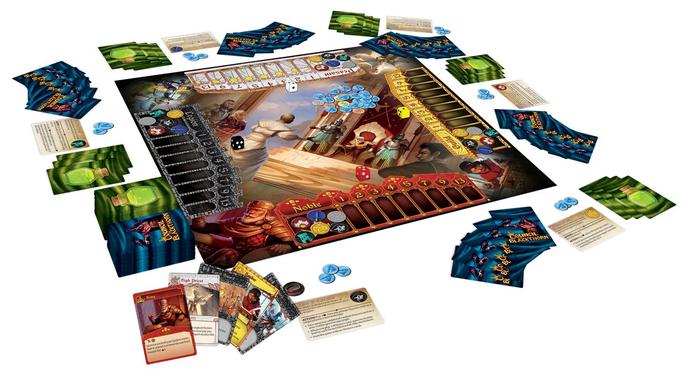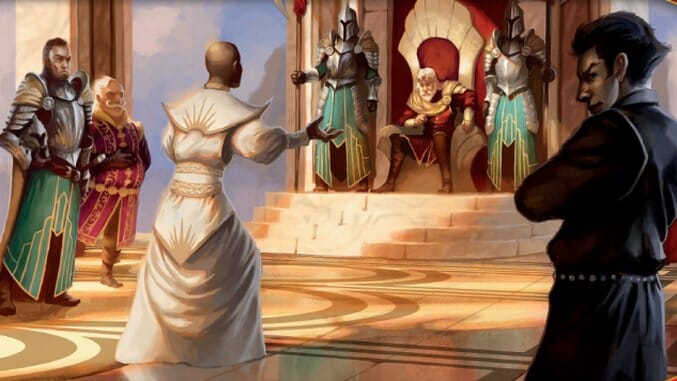Council of Blackthorn is a highly interactive game for two to four players with a novel mechanic that forces players to pursue balanced strategies. Players try to use dice and play cards to move their tokens up four influence tracks, which gains them points but also enables them to use increasingly powerful cards to help themselves or steal things from their opponents. At the end of the game, the player with the most points wins unless that same player has the most points on Treason cards, in which case he’s the automatic loser—the one place where the game’s internal balance goes astray.
Players in Blackthorn are royal advisers fighting for influence with the king by way of four factions: the peasants, the legion (army), the guild (clergy), and the noble. Each player gets to choose one of six characters, each of which has some special actions or abilities that provide little (or occasionally big) benefits throughout the game, such as starting out above zero on one of the faction tracks, increasing the player’s maximum number of cards in hand, or allowing for the discard of certain Treason cards.
On a turn, a player rolls four dice, one in each color, with values from 0 to 3, and then chooses a card to play from his/her hand. Each card has a color as well, so the player moves up the influence track in that color/faction by the number on the die. If the value is 1 or 2, the player just moves up one or two places. If the value is 3, the player moves up 3 places but takes two Treason cards, each of which also has a value of 0 to 3, which are added up at game-end to determine who gets beheaded. (Figuratively.) Once per turn, each player may take one action from either his character card or one of his building cards as well. At the end of each turn, a player receives immediate points for leading on any faction tracks—two points for each track where s/he is alone in the lead, one if there’s a tie, so up to eight points per turn.
Each card also has a text effect, which can be immediate and one-time or ongoing, but a player can only use that text effect if the relevant die’s value is 0 or if the player matches the influence condition on the lower half of the card. That condition always involves a different faction than the color of the card, so the player has to have a certain level of influence in that second faction (usually between 2 and 5 on the track, depending on the power of the card). Some cards are discarded after playing, but others are Buildings, which remain in front of the player for the remainder of the game and confer up to 6 more victory points at game-end.

When a player plays a card where the relevant die value is 0, s/he can also give away a Treason card at random to another player. That’s key because it’s the only mechanism for disposing of Treason cards available at any time to all players. There are certain cards in the deck that allow for the discard of Treason cards or for a player to give one or more to other players, but it’s the luck of the draw whether you ever see one. That means that playing cards on 0-value dice is important early in the game, to trigger text effects on cards, and it’s important later in the game, to get rid of Treason cards, which can place a real drag as the players approach end-game.
The influence tracks start to jump in value beyond 5, to 7, 9, and then 13 in the final space, representing the points each player gets in the final count. Once a player reaches space 13 in any track, that space is then blocked to other players; when three of the 13 spaces on the four faction tracks are occupied, the game ends immediately and the scoring begins. Players add their points in hand, the point values of their spaces on the four faction tracks, and all points from buildings. After this, players add the points on their Treason cards; whichever player has the most Treason points is automatically out of the game, regardless of how many victory points s/he has. (We played one three-player game where I had 110 victory points, the highest score any of us has achieved, but lost because I had the most Treason points by a huge margin and relatively few opportunities to ditch them.)
The game is primarily designed for three to six players, but includes rules for a two-player variant that works just fine. It involves a “dummy” player, although it’s fairly non-intrusive: the dummy player has tokens on the four influence tracks but collects no points or Treason cards. On the dummy’s “turn,” players draw one card and move the dummy player’s influence token up the appropriate track; certain cards will also hand Treason cards to the real players.
My ten-year-old daughter insisted that I say in my review that, while she liked the game, she found the rules around when you could use a card’s text effect—the card has one color, but depends on your influence level in a different color—very confusing. The rules around die rolls of 0 and 3 are smart, but not that clearly explained in the main rulebook. (The explanations on the backs of the player reference cards are clearer and more concise.)
Much of this would be alleviated by multiple plays, and with setup and gameplay both quick—with three players we’d finish in under 45 minutes—it’s easy to keep coming back to it and getting that baseline of familiarity. But the hitch with the Treason cards throws off the balance: the game needs to provide more opportunities for players to ditch these cards, whether it’s by paying points or by the introduction of more cards and buildings that allow it. This could be addressed by additional cards in an expansion, or a tweak to the rules, to bring the game in better balance, because beyond that frustration, Council of Blackthorn works extremely well, from its level of competition to the pace of the game to the variety of strategies players can employ.
Keith Law is a senior baseball writer for ESPN.com and an analyst on ESPN’s Baseball Tonight. You can read his baseball content at search.espn.go.com/keith-law and his personal blog the dish, covering games, literature, and more, at meadowparty.com/blog.
